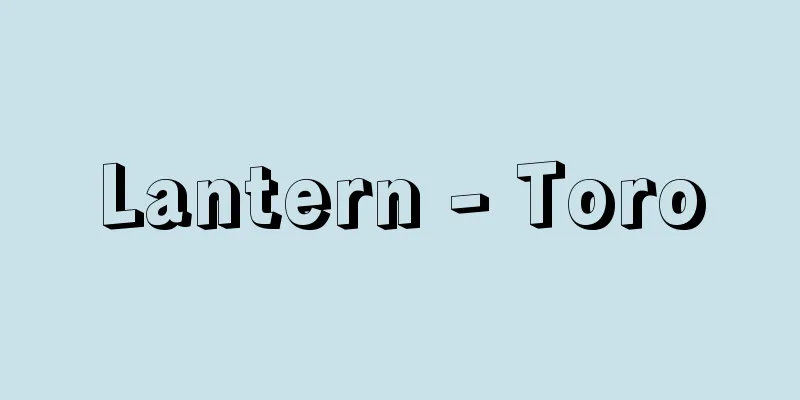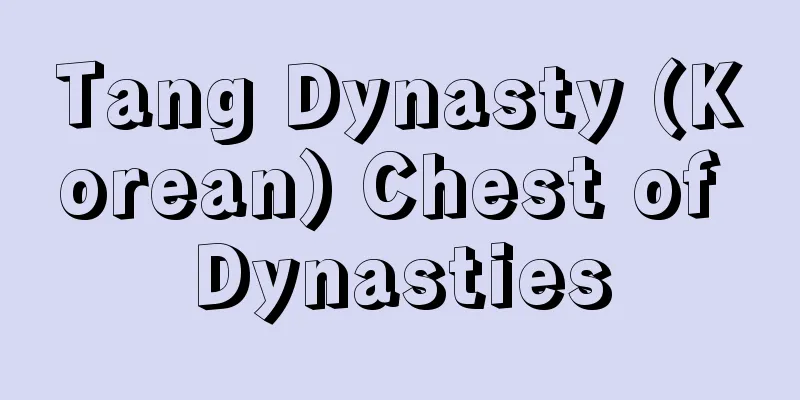Lantern - Toro

|
A type of lighting fixture. Also written as 'toro'. Broadly speaking, they are divided into pedestal lanterns and hanging lanterns, each of which is made of wood, stone, copper, iron, etc. Pedestal lanterns include standing lanterns and table lanterns, while hanging lanterns include hanging lanterns and hanging lanterns. Lanterns were used to offer lamps to gods and Buddhas, to light traffic, and in gardens, garden lanterns were placed for aesthetic purposes. Famous examples of old stone lanterns still in existence include a tuff one from the Nara period in front of the main hall of Taima-ji Temple in Nara, and a granite one from the Heian period at Kasuga Taisha Shrine in Nara. The only stone lantern bases that have been excavated are the marble bases from when the temple was built in the Asuka period at Asuka-dera Temple in Nara. Famous copper lanterns include the Nara period copper lantern in front of the Great Buddha Hall of Todai-ji Temple in Nara, and the Heian period copper lantern in front of the Southern Round Hall of Kofuku-ji Temple in Nara. Other old hanging lanterns include the Kamakura period iron lantern at Todai-ji Temple in Nara, and the copper lantern from the Northern and Southern Dynasties at Itsukushima Shrine in Hiroshima. A pedestal lantern consists of a jewel, a cap, a fire box, a base, a pole, and a pedestal. Some freestanding lanterns omit the pole and below. Standing lanterns are diverse, with some having a flower decoration under the jewel, some with bracken handles on the corners of the cap, some with square or octagonal fire boxes, some with a flower decoration under the base and flowers carved on the base, some with square or circular poles, and some with a ring or knots for string. Representative lanterns are named after the places where they are located, including the Hannyaji style, Gangoji style, Sangatsudo style, Uzumasa style, Yunoki style, Nishinoya style, Okunoin style, Rengeji style, and Zendoji style. Garden lanterns are named after people who used them, including the Juko style, Rikyu style, Enshu style, and Oribe style, and depending on the shape there are types such as Hotaru lanterns and Yukimi lanterns. Hanging lanterns consist of a jewel, a hanging ring, a shade, a fire box, a base, and legs, and the fire box is often ornately carved. Among the lanterns built for the convenience of transportation are the tall lantern in the northern gardens of Kotohira Shrine in Kagawa Prefecture and the eternal light on the shores of Lake Otsubiwa in Shiga Prefecture. [Kudou Yoshiaki] "Japanese Garden Collection: Lanterns" edited by Masao Nakamura and Fumitaka Nishizawa (1985, Shogakukan) " "Dictionary of Japanese Stone Art by Masataro Kawakatsu (1978, Tokyodo Publishing)" ©Shogakukan "> Names of the various parts of the pedestal lantern Source: Shogakukan Encyclopedia Nipponica About Encyclopedia Nipponica Information | Legend |
|
照明具の一つ。灯楼とも書く。大別すると台灯籠と釣(つり)灯籠に分かれ、それぞれ、木製、石製、銅製、鉄製などの種類がある。台灯籠には立(たち)灯籠と置(おき)灯籠、釣灯籠には下げ灯籠と懸(かけ)灯籠がある。灯籠は神仏に灯明を献ずるためや、交通の照明としてのほか、庭園内では鑑賞のための庭灯籠が置かれた。 現存する石灯籠として古いものでは、奈良・當麻(たいま)寺金堂前にある奈良時代の凝灰岩のものや、奈良・春日(かすが)大社の平安時代の花崗(かこう)岩のものが有名である。石灯籠の台座だけは奈良・飛鳥(あすか)寺で飛鳥時代創建時の大理石の台座が出土している。銅製のものでは奈良・東大寺大仏殿前の奈良時代の銅灯籠、奈良・興福寺南円堂前の平安時代の銅灯籠が著名である。また、古い釣灯籠には、奈良・東大寺の鎌倉時代の鉄灯籠や広島・厳島(いつくしま)神社の南北朝の銅灯籠がある。 台灯籠は宝珠、笠(かさ)、火袋(ひぶくろ)、中台(ちゅうだい)、竿(さお)、台座からなる。置灯籠では竿以下が省略されるものもある。立灯籠では宝珠下に受花(うけばな)をつくるもの、笠の隅が蕨手(わらびて)となるもの、火袋が四角形や八角形のもの、中台下に受花、台座上に反花(かえりばな)を刻むものをはじめ、竿も角形・円形があり、覆輪(ふくりん)や紐(ひも)を巡らす節(ふし)をつけるものなど、多様である。その代表的なものの所在する場所名を付して、般若寺(はんにゃじ)形、元興寺(がんごうじ)形、三月堂形、太秦(うずまさ)形、柚(ゆ)の木(き)形、西の屋形、奥の院形、蓮華寺(れんげじ)形、善導寺形などがある。庭灯籠にはそれを愛用した人名をとり、珠光(じゅこう)形、利休(りきゅう)形、遠州(えんしゅう)形、織部(おりべ)形などがあり、形態によって蛍(ほたる)灯籠、雪見(ゆきみ)灯籠などの種類がある。釣灯籠は宝珠、吊輪(つりわ)、笠、火袋、受台、脚からなり、火袋には透(すかし)彫りが施され華麗なものが多い。 交通の便を図ってつくられた灯籠としては、香川・金刀比羅宮(ことひらぐう)北神苑の高灯籠、滋賀・大津琵琶(おおつびわ)湖畔の常夜灯が巨大なものとして知られている。 [工藤圭章] 『中村昌生・西澤文隆監修『日本庭園集成 燈籠』(1985・小学館)』▽『川勝政太郎著『日本石造美術辞典』(1978・東京堂出版)』 ©Shogakukan"> 台灯籠の各部名称 出典 小学館 日本大百科全書(ニッポニカ)日本大百科全書(ニッポニカ)について 情報 | 凡例 |
<<: Lantern Dance - Lantern Dance
>>: Road - Doro (English spelling) road
Recommend
Snail-worm
A type of small spiral-shelled worm belonging to ...
threatening coloration
...The former are classified as protective colors...
Tadaatsu Ishiguro
A bureaucratic leader known as the leading figure ...
Ota-juku
...Tobu Isesaki Line runs through here, and the K...
Birth Buddha - Tanjobutsu
Abbreviation of "Born Buddha" (Shakabut...
William, H. (English spelling) William H
…English surgeon. Born in Long Calderwood, Scotla...
image sensor
…There are two types of multi-channel: one-dimens...
Dvin
The ruins of a city near the village of Upper Dovi...
Passerinae
…The subfamily Bubalornithinae includes the Afric...
Asbury, F.
…At the time of his death on March 2, 1891, Metho...
Initiation reaction - Initiation reaction
An elementary reaction that acts as a trigger for...
Yamato-e - Yamato-e
It is also written as Wa-e, Yamato-e, or Wa-e. As ...
Aloe emodin - Aloe emodin
…The folk medicine Aloe vera was introduced to Ja...
Ozone layer
The area of high ozone concentration in the upp...
Akachin - Akachin
〘Noun〙 ("Chin" is an abbreviation of &qu...









